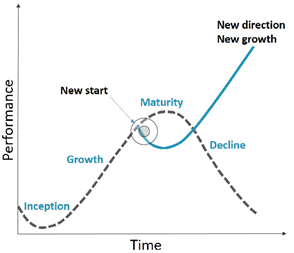[vc_row][vc_column][vc_column_text]Our world is in a turbulent phase, like an oyster writhing to resist the grain of sand before it creates a pearl. Things we took for granted are no longer a given. Think about reproductive rights, home ownership, democracy or a thriving Great Barrier Reef. The stats from the Edelman trust barometer show that 56% of Australians think the system isn’t working for them.
Complacency is the enemy of innovation and the hidden threat to your future success. Just ask Blockbuster Video, My Space or Kodak. As we embark on a new financial year, you need to avoid the complacency trap and plan ahead for reinvigorating your corporate partnerships. Otherwise, like a long-married couple, you might find you have nothing in common once the kids finally move out.
The management writer Charles Handy talks of the need to plan for the ‘second curve’. There is an inevitable life cycle of things, whether they be products or empires. The trick is to start the second curve whilst the other one is in full swing and looking successful, rather than in terminal decline. It will look something like this:
Financial advisors will tell you that no-one ever picks the true peak of a market. Overconfidence and complacency gives us a false sense of security and a set of blinkers. If you have partnerships that are going well, don’t assume this will always be the case. Often you need to take a back step to reinvest or reinvent the partnership, to avoid the downturn.
Sometimes it can be hard to read the warning signs in a partnership. Equally you could be making excuses. “I’m too busy.” “I’ve got to look for new partners.” “They’ve been with us for while and they don’t need as much attention”. Before you know it, you’re on the slippery slope of decline. Charles Handy notes that the average lifespan of a business was 40 years before collapsing or being taken over; now it’s more like 14 years. Your corporate partner could be facing a bunch of business issues that could materially impact on your partnership.
Here are some quick tips to avoid the trap of complacency and ensure you embrace the second curve of opportunity.
- Focus on creating a vision for the partnership. We know that your organisation has a vision, but do you have one for the partnership that is commonly understood by both of you and guides your goals and actions? Don’t get obsessed by what’s in front of you and the day to day of processes activations and budgets. Raise your eyes to the horizon and think ambitiously.
- Take time to uncover what’s really going on in your partner’s business and industry sector. Asking about their business will uncover ways in which you can be part of the solution to their challenges. For example, the construction industry is in the midst of a crisis with rising costs, skinny margins and a shortage of labour. How can you help with retaining key talent? Do you have solutions for their sustainability challenges?
- Make sure you’re reporting on the whole value of the partnership to your corporate partner. You’re probably comfortable with program reports and beneficiaries, but what about the other value you bring? Corporates are interested in the social media profile, levels of engagement, staff surveys and feedback from key target audiences. You’ll need to help them with the metrics that feed their ESG score to ensure that your partnership is one that’s worth the investment.
- Thank them regularly and do it publicly. A third-party post that recognises their commitment is worth ten times a piece of paid advertising. Give them shareable content that they can use with their staff, customers and investors. Make sure you’re not taking a long-term partner for granted.
Upheaval and chaos are an inevitable part of our changing world. To help your partnerships thrive and grow you need to avoid the trap of complacency and look for the second curve.[/vc_column_text][/vc_column][/vc_row][vc_row][vc_column][vc_column_text][activecampaign form=1 css=1][/vc_column_text][/vc_column][/vc_row]


